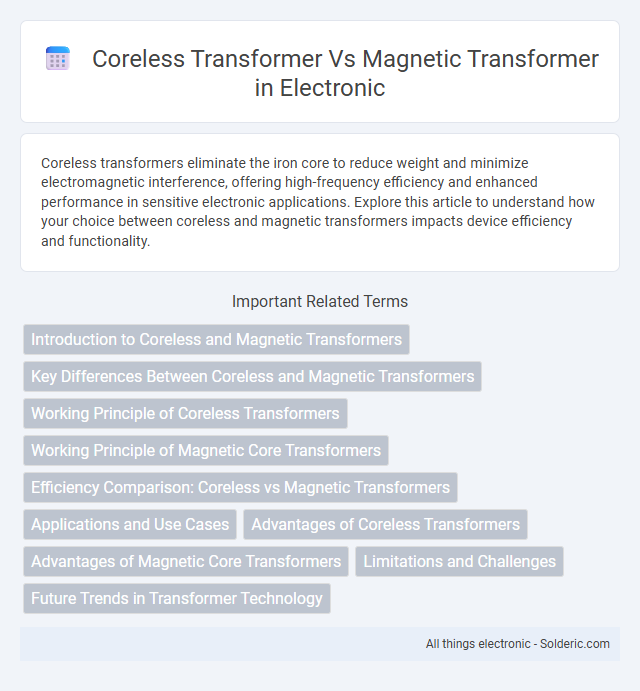Coreless transformers eliminate the iron core to reduce weight and minimize electromagnetic interference, offering high-frequency efficiency and enhanced performance in sensitive electronic applications. Explore this article to understand how your choice between coreless and magnetic transformers impacts device efficiency and functionality.
Comparison Table
| Feature | Coreless Transformer | Magnetic Transformer |
|---|---|---|
| Magnetic Core | Absent | Present (Iron or Ferrite Core) |
| Size & Weight | Compact, Lightweight | Bulkier, Heavier |
| Efficiency | Lower due to leakage inductance | High, less energy loss |
| Frequency Range | High-frequency operation (MHz range) | Low to mid-frequency (kHz range) |
| Applications | Wireless power transfer, RF circuits | Power supplies, electrical isolation |
| Cost | Generally higher manufacturing cost | Cost-effective for large power ratings |
| Thermal Performance | Better heat dissipation without core losses | Core heating can limit performance |
Introduction to Coreless and Magnetic Transformers
Coreless transformers operate without a ferromagnetic core, relying on air or other non-magnetic materials to transfer energy through electromagnetic induction, which reduces core losses and improves efficiency at high frequencies. Magnetic transformers utilize a laminated iron or ferrite core to concentrate the magnetic flux, enhancing voltage transformation efficiency and minimizing energy loss in low-frequency applications. Choosing between coreless and magnetic transformers depends on factors such as frequency range, size constraints, efficiency requirements, and thermal management.
Key Differences Between Coreless and Magnetic Transformers
Coreless transformers utilize a design without a magnetic core, relying on air or vacuum as the magnetic path, which leads to reduced core losses and improved high-frequency performance compared to traditional magnetic transformers that use iron or ferrite cores to concentrate magnetic flux. Magnetic transformers exhibit higher efficiency at low frequencies due to their laminated cores minimizing eddy currents, while coreless transformers excel in applications requiring lightweight, compact size, and minimal interference. The key differences lie in energy loss mechanisms, operating frequency range, and physical structure, making coreless transformers ideal for high-frequency, low-power scenarios, and magnetic transformers suitable for power distribution and low-frequency applications.
Working Principle of Coreless Transformers
Coreless transformers operate on the principle of electromagnetic induction without a ferromagnetic core, relying solely on air or vacuum as the medium for magnetic flux linkage. The absence of a core reduces core losses such as hysteresis and eddy currents, resulting in improved efficiency at high frequencies. Magnetic transformers, by contrast, depend on a ferromagnetic core to concentrate magnetic flux, enhancing coupling between primary and secondary coils but introducing core losses and saturation limits.
Working Principle of Magnetic Core Transformers
Magnetic core transformers operate on the principle of electromagnetic induction, where alternating current (AC) in the primary coil creates a time-varying magnetic flux in the ferromagnetic core. This magnetic flux is efficiently coupled to the secondary coil, inducing a voltage proportional to the turns ratio between the coils. The magnetic core enhances flux linkage and reduces energy loss, enabling high efficiency and compact size in power transfer applications.
Efficiency Comparison: Coreless vs Magnetic Transformers
Coreless transformers offer higher efficiency by eliminating core losses such as hysteresis and eddy current losses found in magnetic transformers. Your applications benefit from reduced energy dissipation and improved thermal management due to the air-core design of coreless transformers. Magnetic transformers, while more compact and cost-effective, typically experience lower efficiency because of core material limitations and associated energy losses.
Applications and Use Cases
Coreless transformers excel in high-frequency applications such as wireless power transfer, precision sensors, and medical devices due to their low core losses and reduced electromagnetic interference. Magnetic transformers, featuring iron or ferrite cores, are widely used in power distribution, audio electronics, and industrial machinery where efficient energy transfer and voltage regulation are critical. Your choice depends on whether efficiency at high frequencies or robust power handling in conventional systems is prioritized.
Advantages of Coreless Transformers
Coreless transformers offer significant advantages over magnetic transformers, including reduced electromagnetic interference (EMI) due to the absence of a magnetic core, which enhances signal integrity in sensitive electronic applications. Their lightweight and compact design minimizes energy losses and heat generation, improving efficiency and reliability in high-frequency circuits. Coreless transformers also provide faster transient response and lower audible noise, making them ideal for precision instrumentation and telecommunications.
Advantages of Magnetic Core Transformers
Magnetic core transformers exhibit higher efficiency due to reduced core losses and improved magnetic flux concentration compared to coreless transformers. They provide superior voltage regulation and can handle higher power ratings, making them ideal for industrial and heavy-duty applications. The magnetic core design also minimizes electromagnetic interference, enhancing overall operational stability and safety.
Limitations and Challenges
Coreless transformers face challenges such as lower efficiency and reduced voltage regulation compared to magnetic transformers, due to the absence of a magnetic core to concentrate the magnetic flux. Magnetic transformers, while typically more efficient, encounter limitations including increased size, weight, and core losses such as hysteresis and eddy currents, which can impact performance and thermal management. Your choice between the two must consider these trade-offs, balancing efficiency, size constraints, and application-specific requirements.
Future Trends in Transformer Technology
Coreless transformers are emerging as a promising technology with advantages in reduced weight, improved efficiency, and enhanced high-frequency performance compared to traditional magnetic transformers. Advances in materials such as amorphous metals and nanocrystalline cores are driving the evolution of magnetic transformers toward higher power density and lower losses. Future trends emphasize integrating smart monitoring systems, wireless power transfer capabilities, and scalable designs to support renewable energy integration and electric vehicle infrastructure.
Coreless Transformer vs Magnetic Transformer Infographic

 solderic.com
solderic.com